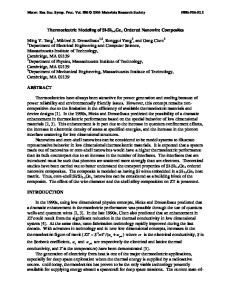Synthesizing and Subsequent Annealing of Si-based Thermoelectric Material Ba 8 Au x Si 46- x Clathrates
- PDF / 26,372,452 Bytes
- 5 Pages / 612 x 792 pts (letter) Page_size
- 86 Downloads / 319 Views
Synthesizing and Subsequent Annealing of Si-based Thermoelectric Material Ba8AuxSi46-x Clathrates Bin Liu1, Makoto Saisho1, Yuya Nagatomo1, Mikihito Tajiri1, Yusuke Nakakohara1, Osamu Furukimi1, Ryo Teranishi1 and Shinji Munetoh1 1 Department of Materials Science and Engineering, Kyushu University, Fukuoka, Japan. ABSTRACT We prepared the type-I Ba8AuxSi46-x (x=5.5, 5.4 and 5.33) clathrates with p-type conduction by arc-melting and subsequent annealing. The Seebeck coefficients of all assynthesized samples were negative. After annealing, in the case of x=5.4 and 5.5, the Seebeck coefficients changed to positive, and in the case of x=5.33, this value was negative for the annealed sample. The chemical composition revealed that Au content in the Ba8AuxSi46-x clathrates increased after the annealing process. The backscattered electron images showed that there were many Au-excess regions which were not clathrate structure in the as-synthesized samples, and these regions decreased and even disappeared after the annealing process. The disappearing of Au-excess regions can be explained by the diffusion of Au atoms from the Auexcess regions into the clathrates. Based on these results, annealing treatment can be used to tune the carrier conduction by controlling the content of Au for type-I Ba8AuxSi46-x clathrates. INTRODUCTION Thermoelectric solids are promising materials in the scope of energy saving for example converting wasted heat in automobile or garbage furnace into electricity [1]. Recently, the type-I clathrate compounds have been extensively studied as promising candidates for thermoelectric materials because of the phonon glass, electron crystal (PGEC) concept which was first introduced by Slack in 1995. The PGEC concept supposes that heat transfer is suppressed by phonon scattering, but electric transport remains high due to the periodic regulations in the lattice [2,3]. The formula of type-I clathrates can be summarized as M8TrxTt46-x, where M is usually Sr, Ba or Eu, Tr is group 13 element or transition metal like Au, Ag, Cu or Ni, Tt is group 14 element Si, Ge or Sn. The unit cell of type-I clathrates consists of two dodecahedra cages and six tetrakaidecahedra cages formed by Tr and Tt atoms. M atoms site in the center of the cages [4,5]. Using the classical Zintl–Klemm rules, one M atom donates 2 electrons to the clathrates framework and the Tr atoms accept the donated electrons to achieve similar electron structure with group 14 element to built the framework with Tt atoms [6]. Some Zintl compounds allow both n- and p-type compositions to be achieved [7]. Both n-type and p-type materials are necessary to built thermoelectric module. However, many clathrate materials appear to be n-type, in which concentration of electron donated by alkaline-earth is lager than that of holes donated by framework host atoms [8,9]. Many researches have been forced on type-I Ba8Ga16Ge30 clathrates which have shown very good thermoelectric properties. P-type Ba8Ga16Ge30 clathrates have been reported in several papers [7]. In some











